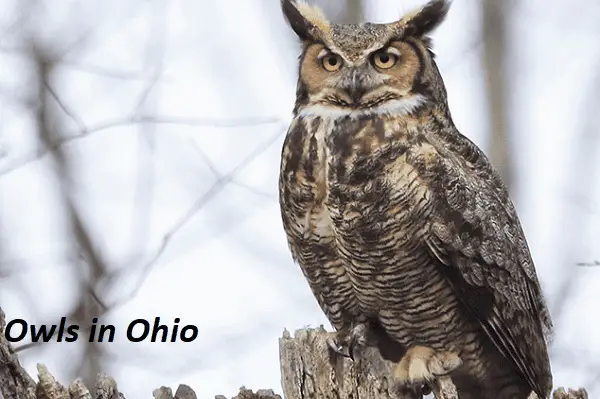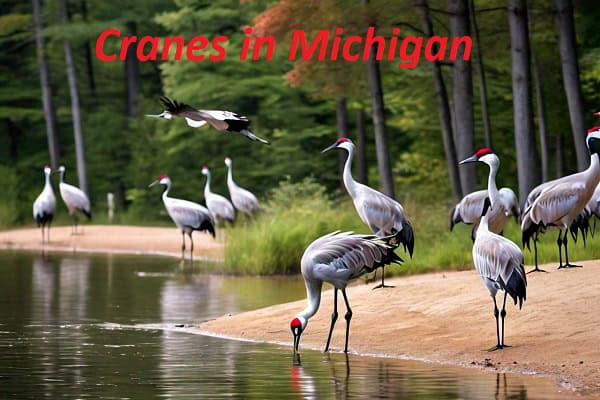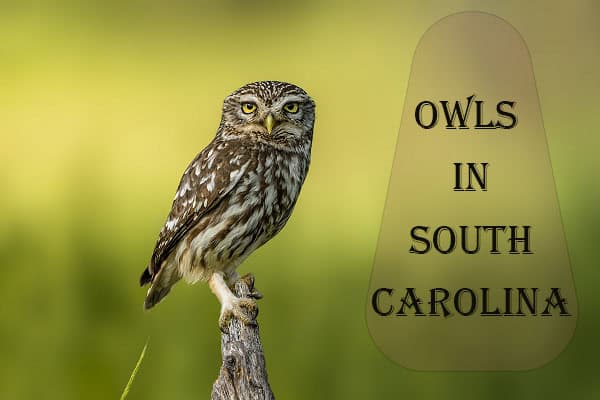Top 7 Types of Owls in Ohio (With Pictures)
Did you know that Ohio is home to a mesmerizing array of owls species? From the majestic snowy owl to the elusive eastern screech owl, the state of Ohio offers a diverse habitat that attracts these captivating creatures. Whether you’re an owl enthusiast or simply curious about these extraordinary birds, exploring the various habitats and unique behaviors of Owls in Ohio will never cease to amaze you.
Here, You’ll Learn About 7 Different Types Of Owls Found In Ohio
1. Eastern Screech-Owl
The eastern screech owl, one of Ohio’s most common owl species, can be found throughout the state’s woodlands and deciduous forests. These small owls have adapted well to Ohio’s diverse landscape, making them a familiar sight and a favorite among bird watchers and nature enthusiasts.
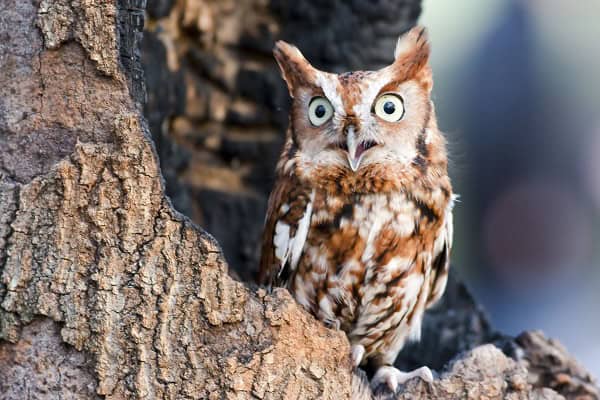
One of the reasons for the eastern screech owl’s success in Ohio is its ability to utilize nest boxes and tree cavities for nesting. These adaptable owls are known to take advantage of man-made nest boxes as well as natural tree cavities, making them resourceful dwellers in their woodland habitats.
The eastern screech owl’s preferred hunting grounds are often located near its nesting sites. These owls blend seamlessly with their surroundings, relying on their exceptional camouflage to sneak up on their prey. They have excellent night vision and sharp hearing, enabling them to navigate through the dense foliage of the woodland areas and hunt efficiently.
To better understand the significance of the eastern screech owls in Ohio, let’s take a closer look at their preferred habitats and nesting behaviors:
Habitats:
The eastern screech-owl thrives in woodlands and deciduous forests, where it can find an abundance of prey and suitable nesting sites. These habitats offer the perfect blend of cover and open spaces, providing the owls with opportunities to hide and hunt.
Nesting:
Nest boxes and tree cavities are the primary nesting sites for eastern screech owls in Ohio. These cavities can be found in various types of trees, such as oak, maple, and hickory. The owls use their natural ability to blend in with the tree bark, making it difficult for predators to detect their nests.
Overall, the eastern screech owl is a fascinating owl species that has successfully adapted to Ohio’s woodlands. Its ability to utilize nest boxes and tree cavities, combined with its remarkable camouflage and hunting skills, make it a common and beloved resident of the state.
Comparing Ohio Owls’ Habitat Preferences
| Owl Species | Preferred Habitats |
|---|---|
| Eastern Screech-Owl | Woodlands, Deciduous Forests |
| Great Horned Owl | Various habitats including forests, open spaces |
| American Barn Owl | Open habitats, grasslands, meadows |
| Barred Owl | Woodlands, forests, swampy areas |
2. Great Horned Owl
The great horned owl is a magnificent species found in Ohio, known for its majestic appearance and impressive nocturnal hunting abilities. With its distinct features and powerful presence, this owl species captivates bird enthusiasts and nature lovers alike.
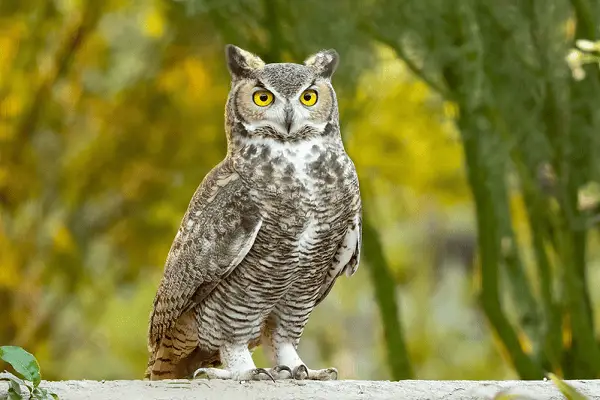
As a nocturnal predator, the great horned owl takes advantage of the cover of darkness to search for its prey. Its acute hearing allows it to locate small mammals, such as voles and shrews, even in low-light conditions. Stealthily gliding through the night sky, this owl strikes with precision, making it a formidable hunter.
The great horned owl’s hunting grounds are diverse, making it adaptable to various environments. From dense forests to open fields, this owl is capable of thriving in different habitats throughout Ohio. It is often found near hawk nests, taking advantage of the opportunity to prey on the hatchlings.
“The great horned owl’s ability to prey on hawk nests showcases its impressive hunting prowess and opportunistic nature.”
With its exceptional vision and silent flight, the great horned owl is a skilled predator that plays a vital role in maintaining the balance of ecosystems. Its presence in Ohio’s natural landscapes is crucial for controlling populations of small mammals, contributing to the overall health and biodiversity of the region.
Hunting Habits of the Great Horned Owl
| Hunting Behavior | Description |
|---|---|
| Nocturnal | The great horned owl is most active during the night, capitalizing on its excellent night vision and hearing to locate prey. |
| Prey | Small mammals such as voles and shrews are the preferred prey of this owl, which it can catch with its sharp talons. |
| Hunting Grounds | The great horned owl can be found in a variety of habitats, including forests, fields, and even urban areas. It often preys on hawk nests to take advantage of vulnerable hatchlings. |
| Acute Hearing | This owl possesses remarkable hearing capabilities, allowing it to detect even the slightest sounds produced by its prey. |
3. American Barn Owl
When it comes to Ohio’s owl population, the American barn owl is a fascinating species to explore. Known for its silent flight and exceptional hunting skills, this owl has made its mark in the open habitats of the Buckeye State.
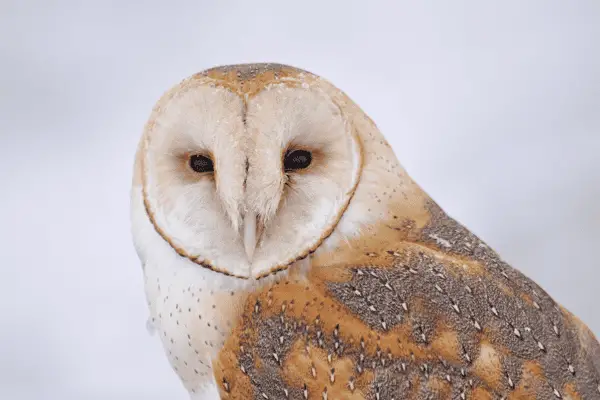
If you’re an owl enthusiast or simply curious about these magnificent creatures, Ohio’s Metroparks offer excellent opportunities to spot the American barn owl. Its preference for open habitats, such as grasslands and meadows, makes these areas the perfect hunting grounds for this elusive bird.
“The American barn owl’s ability to silently glide through the air and scan its surroundings with precision is truly remarkable,” says Sarah Johnson, an avid bird watcher at Ohio Metroparks. “Seeing it in action is a sight to behold.”
While the American barn owl is a year-round resident in some parts of the country, in Ohio, it primarily visits during the winter months. These winter visitors create an enchanting sight against the backdrop of snow-covered fields and frozen landscapes.
American barn owls are known for their distinctive heart-shaped faces and ghostly white plumage. These nocturnal hunters rely on their exceptional hearing to locate their prey, which mainly consists of small mammals like mice and voles.
The Perfect Winter Encounter
Ohio’s metroparks provide the ideal setting to observe the American barn owl’s hunting prowess during the winter season. With their patience and precision, these magnificent birds become a living testament to the wonders of nature.
Whether you’re a seasoned birder or simply enjoy immersing yourself in the beauty of wildlife, a winter encounter with the American barn owl is an experience you won’t want to miss.
So, next time you find yourself wandering through Ohio’s metroparks, keep an eye out for the silent stalker of the night sky – the American barn owl. Witnessing its graceful flight and stealthy hunting techniques is sure to leave you in awe.
4. Barred Owl
The barred owl, a fascinating species native to Ohio, is known for its distinctive vocalizations and captivating presence. These owls have a unique call that sets them apart from other owl species, making them easily recognizable in the wilderness.

When it comes to nesting, the barred owl exhibits an interesting behavior. They prefer tree cavities as their nesting sites, utilizing the natural hollows of old trees to create a cozy home for their young. These tree cavities provide the perfect shelter, protecting the nest from predators and the elements.
One of the most remarkable characteristics of the barred owl is its vocal repertoire. Their calls include a series of hoots that sound like the phrase “who cooks for you? who cooks for you all?” These vocalizations echo through the open areas of Ohio’s forests, allowing other members of their species to communicate and establish territories.
The barred owl’s unique call is a true representation of the enchanting wildlife found in Ohio’s diverse habitats.
When it comes to hunting, the barred owl has well-defined hunting grounds. Their keen senses and ability to navigate through dense woodlands make them formidable predators. Small mammals, such as squirrels and rabbits, are often their primary prey, which they can snatch with remarkable accuracy and precision.
Importance of Conservation
The preservation of open areas and tree cavities is crucial to the survival of the barred owl population in Ohio. These unique habitats provide the necessary resources for nesting and hunting, ensuring the continued presence of these majestic creatures.
By understanding and appreciating the unique characteristics of the barred owl, we can contribute to their conservation efforts and protect the delicate balance of Ohio’s ecosystems.
5. Snowy Owl
The snowy owl is a majestic bird that originates from the Arctic region and occasionally makes its way to Ohio. These magnificent creatures are known for their stunning white plumage and striking yellow eyes.

In their natural habitat, snowy owls thrive in the vast tundra landscapes where they can blend perfectly with the snowy surroundings. But during certain times of the year, they undertake long migrations to different parts of the world, including Ohio.
When snowy owls visit Ohio, they can often be spotted near airports. These open areas with wide expanses resemble the tundra habitats they typically inhabit. The airports provide an excellent vantage point for hunting prey and resting during their journey.
It’s a breathtaking sight to witness a snowy owl perched on a runway sign or gliding gracefully across the sky. These Arctic visitors add a touch of elegance to the Ohio landscape.
Being primarily crepuscular hunters, snowy owls are most active during dawn and dusk. Their impeccable eyesight and powerful flight enable them to cover vast distances in search of their prey. During the dusk, they soar across the horizon in pursuit of small mammals, such as lemmings and voles, which make up a significant part of their diet.
While their visits to Ohio may be temporary, observing and learning about these magnificent creatures is a rare opportunity that nature enthusiasts and bird watchers eagerly await.
Habitat:
Tundra habitats, airports during migration
Features:
- Stunning white plumage
- Yellow eyes
- Powerful flight
Activity patterns:
Most active during dawn and dusk
Hunting grounds:
Tundra landscapes, airport surroundings
6. Short-Eared Owl
The short-eared owl is a fascinating species that can be found in the grasslands of Ohio. These owls have a unique preference for open habitats, making the vast grasslands their hunting grounds.
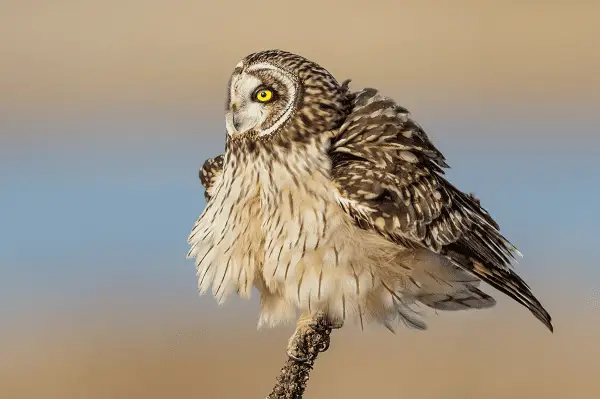
One of the distinctive features of the short-eared owl is its diet, which primarily consists of small rodents. They are skilled hunters, preying on creatures such as meadow voles that inhabit the grassy landscapes. Their ability to adapt to this specific environment allows them to thrive in Ohio’s grasslands.
Unlike other owl species that tend to favor woodlands or forests, the short-eared owl relies on open areas for hunting. This makes them perfectly suited to grasslands and other open habitats. The absence of thick vegetation allows these owls to spot their prey from a distance and swoop down swiftly for an accurate capture.
“The short-eared owl’s preference for open habitats sets them apart from many other owl species. Their ability to hunt efficiently in grasslands makes them unique and fascinating creatures.” – Owl enthusiast
The Importance of Grassland Habitats
The presence of short-eared owls in Ohio’s grasslands highlights the importance of these open habitats. Grasslands provide a necessary ecosystem for various species, including small rodents like meadow voles, which serve as a vital food source for the short-eared owl.
Grasslands also offer suitable nesting sites for these owls. The lack of dense vegetation allows them to build their nests directly on the ground, hidden within the grass. This nesting behavior, along with their hunting grounds in grasslands, further emphasizes their adaptation to this specific habitat.
A Unique Hunting Behavior
Short-eared owls have a distinct hunting behavior that sets them apart from other owl species. They are known for their low, buoyant flight patterns, often gliding silently above the grassy landscapes in search of prey. This hunting style, combined with their acute hearing, allows them to pinpoint the location of small rodents, even when hidden beneath the vegetation.
| Key Features | Short-Eared Owl |
|---|---|
| Habitat Preference | Grasslands and open habitats |
| Main Prey | Small rodents, such as meadow voles |
| Nesting Behavior | Ground-nesting within the grass |
| Hunting Style | Low flight, gliding above the grasslands |
The short-eared owl’s unique hunting behavior makes them a captivating species to observe in the grasslands of Ohio. Their ability to thrive in these open habitats showcases the incredible adaptability of these birds.
7. Long-Eared Owl
Among the fascinating species of owls found in Ohio, the long-eared owl stands out with its unique hunting abilities and choice of habitat. These owls are known for their preference for woodlands, where they can blend seamlessly with the surrounding trees.
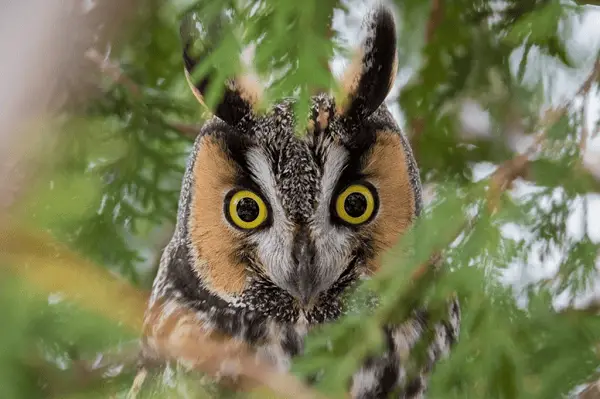
The long-eared owl’s diet mainly consists of small mammals like mice and voles. To nest, they seek out hollow trees in the woodlands, providing a safe and hidden spot for their young. These nesting sites are essential for their survival and breeding success.
When it comes to hunting, the long-eared owl utilizes its natural advantage: silent flight. With a near-silent approach, they become highly efficient hunters in their woodland hunting grounds. Their keen eyesight and acute hearing help them locate and capture their prey without alerting nearby creatures.
If you find yourself exploring the woodlands of Ohio, keep an eye out for the long-eared owl. Witnessing their stealthy flight and observing their woodland hunting techniques is a truly remarkable experience.

